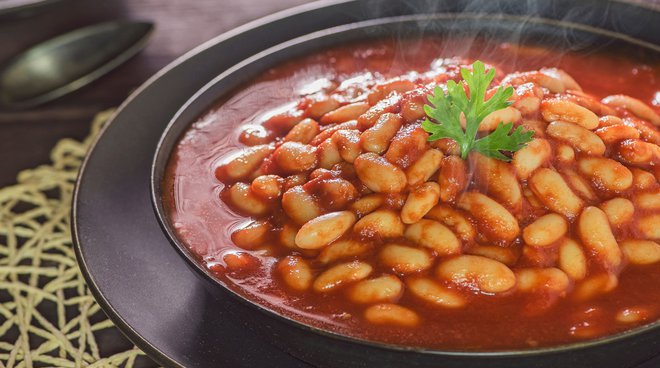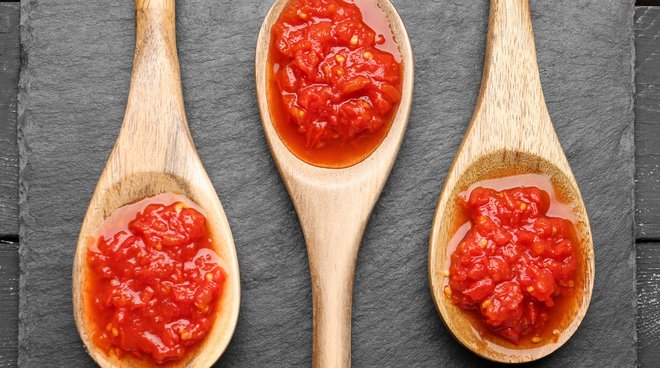Pulp, Passata and Related Products
HOW TO PREPARE REAL ITALIAN SPAGHETTI WITH POMÌ INGREDIENTS
How can you prepare Italian spaghetti? This delicious first course is to all intents and purposes one of the most famous icons of Mediterranean cuisine.

And whether it's a simple arrabbiata sauce or a more elaborate pasta alla puttanesca, with Pomì, 100% Italian taste is more than guaranteed!
In this guide, we’ll explore how to prepare spaghetti using Pomì products, sharing Italian recipes and tips on how to season pasta in the most delicious way possible.
How to prepare Italian spaghetti: the secret of perfect cooking
- Water and salt: bring a large pot of salted water to the boil. Use about 10 grams of salt per litre of water.
- Spaghetti: add the spaghetti when the water boils, and cook according to the instructions on the package, making sure the pasta is al dente.
Arrabbiata sauce with Pomì ingredients
- Preparation of the base: in a frying pan, heat olive oil and add chopped garlic and chilli pepper.
- Add the Pomì sauce: pour in the Pomì tomato puree, stir and cook for 10-15 minutes, adjusting the flavour with salt, chilli pepper, parsley and extra virgin olive oil.
How to season the spaghetti
- Draining: drain the spaghetti al dente, keeping some cooking water aside.
- Adding the sauce: add the spaghetti to the arrabbiata sauce with a tablespoon or two of cooking water - if necessary.
- Final touches: serve immediately, garnishing with chopped parsley and a drizzle of extra virgin olive oil.
Alternative Italian recipes with Pomì ingredients
To prepare Italian spaghetti using Pomì tomatoes, there is no need to use the tomato paste - unless you are cooking for a great number of people and want to enrich the flavour of the sauce.
- Spaghetti alla puttanesca: sauce made with olives, capers and tomatoes.
- Spaghetti with fresh tomatoes: fresh tomatoes, basil and garlic.
What are the common mistakes to avoid when preparing spaghetti?
It is important to avoid putting too much water in the pot, as the spaghetti needs space to move without the water boiling over. It is then advisable to check that the water is properly salted to obtain tasty pasta, and to cook the spaghetti al dente to avoid letting them get mushy. Indeed, the perfect spaghetti should always be cooked al dente, so that it retains a pleasant, incisive texture.
Is there a specific way to drain spaghetti?
Yes, it is essential to always leave some cooking water aside before draining the pasta. This starch-rich water helps the sauce to blend better with the pasta, making it thick and helping it cling to the pasta. Adding a spoonful or two in the pan while stirring the pasta into the sauce can in fact strongly influence the final result.
When is the right time to add salt to the water?
The best time to add salt is when the water starts to boil. In this way, the salt will dissolve evenly, flavouring the water optimally. It is important to avoid adding it too early, as it may slow down the boiling, but also not to add it too late. In fact, Italian spaghetti must absorb enough of it during cooking.
How long can I keep leftover spaghetti?
Leftover spaghetti can be stored in the refrigerator in an airtight container for up to three days. Before storing it, it is important to ensure that the spaghetti has completely cooled. To warm them up, you can add a little water or sauce in a pan, to prevent them from drying out or sticking together.
Can I add protein to the sauce?
Yes, adding sausage, bacon or prawns can add an extra touch of flavour to the sauce, resulting in traditional or personal variations, prepared according to one’s taste. The sausage and bacon can be sautéed with garlic and onion to create a rich base - known as Salsa all'amatriciana - while the prawns should be added towards the end of cooking, to prevent them from becoming chewy.
Discover the secrets of Italian cuisine with Pomì!
NEWS
ALSO IN FOOD TRENDS
Pulp, Passata and Related Products
Vegetarian cooking: Middle Eastern recipes with tomato sauce
Vegetarian cuisine has deep roots in many cultures, and Middle Eastern cuisine is by no means an exception.
Pulp, Passata and Related Products
Italian taste meets the Middle East: recipes with Italian tomatoes
When the vibrant flavours of the Middle East merge with Italian tomatoes and the culinary tradition of Italy, dishes are born that are nothing less than an ode to the harmony of tastes.
Pulp, Passata and Related Products
The history of tomato sauce: Arab and Italian traditions
Tomato sauce is undoubtedly one of the most emblematic ingredients of Italian cuisine, but its history actually has its roots in much older cultures and traditions. This condiment, which today represents the essence of Mediterranean cuisine, has a past linked to both Arab and Italian traditions.


